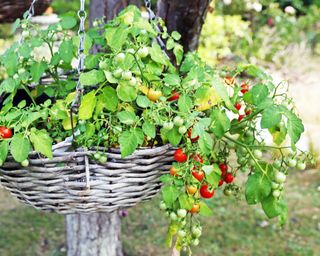How To Make A Tomato Hanging Basket – Ideal For Small Spaces

[ad_1]
Planting a tomato hanging basket is a wonderful space-saving way to grow delicious organic produce. For beginners, it’s also a fantastic first step toward learning how to grow tomatoes.
Tomatoes can be grown tumbling out the top of hanging baskets, or even upside down through holes in the base. Several years ago, the idea of an upside-down tomato planter took the gardening world by storm and is an option worth considering. Growing inverted tomatoes takes advantage of gravity to evenly deliver nutrients and water.
As well as being perfect for small spaces, growing vegetables in hanging baskets has a few other benefits, as it allows the plants plenty of growing space and air circulation, and makes harvesting a breeze.
You can purchase hanging baskets from most garden centers, or make your own. With a bucket and simple tools, you can make a simple planter to hang from the porch, eaves, tree branch, or other high space.
Smaller tomato varieties work best for this type of growing situation. They are also some of the easiest tomatoes to grow.
(Image credit: Alamy)
Benefits Of Tomato Hanging Baskets
Growing tomatoes in a hanging basket allows for freer air movement, which helps to reduce disease. It also allows the gardener to move the plant as needed for maximum sun exposure. Plants don’t need staking or cages and will grow freely, tumbling down from the basket.
The practice also minimizes insect pests that overwinter in garden soil. Few weeds will find their way into a hanging tomato basket.
A hanging tomato gives the easiest access to fresh produce just outside the door. The proximity of juicy, sweet fruit close by provides a quick, nutritious snack.
How To Make A Hanging Tomato Basket
When choosing a hanging basket, you may opt for a wire, wicker, or plastic container. A wire basket should be lined with coir sheeting. Use good potting soil to house the plant.
An inverted basket may be made out of a bucket with a hole drilled in the bottom large enough to fit the plant through. Gently push the foliage through the hole and fill in around the roots remaining in the bucket.
If your bucket has a handle, hang it from that. If not, attach a piece of wire across the top to use as a hanger. Choose a light-colored container if possible. Darker colors will make the tomato plant roots too hot.
Other possible vessels are soda bottles, trash bags, and plastic shopping bags.

(Image credit: Shutterstock)
Planting The Basket
For traditional growth, line the basket with your selected material. Choose a potting mix with vermiculite or perlite to hold moisture. A half-and-half mix of potting soil and compost will boost growth.
Remove the tomato from the nursery container and gently fluff up the roots. Create a hole large enough to fan out the roots and then backfill with more soil. Water the soil to settle it around the roots.
With an inverted container, push the roots through the hole into the cavity of the container. Fill around the roots, fanning them out. Water the soil to settle it.
Tips On Hanging Your Basket
Depending on the size of your plant at maturity, the hanging basket could contain a lot of soil. When wet this will weigh a lot. Combine this with the destabilizing effects of wind, and you need a very strong support.
Use wall anchors to attach any hanging hardware and consider using a chain as the hanging device.
When selecting the location for your tomato hanging basket, give the plant as much sun as possible. In hotter climates, choose a location where there will be some dappled shade in the hot afternoon. In temperate zones, the plant will perform beautifully in full sun all day.

(Image credit: Alamy)
Caring for A Hanging Tomato
Since the sides of the container are exposed to sun and wind, the container will dry out quickly. Water tomatoes in the morning and then check the soil later in the day to see if it is moist.
When fertilizing tomatoes, use a slow-release product, either added to the soil at planting or worked into the top of the soil.
Pinch out the tips when the plant is young to encourage branching. If blossom end rot occurs, use a specialist product, or a tomato fertilizer with added calcium.
Tips For Growing Upside Down
If you decide to grow plants upside down, bear in mind there is one potential drawback. Since plants want to grow towards the sun, the stems will curve. This can make them weak, prone to breaking, and unable to support fruits.
Choose an indeterminate variety that produces tomatoes over the season rather than all at once like determinate tomatoes. Indeterminate plants also have less rigid, more flexible stems that won’t be harmed by gravity.
Upside-down planters will dry out very quickly and could require watering twice per day. To conserve moisture, top the soil with mulch. It also helps to line the interior of the container with landscape fabric or coir to contain moisture.

(Image credit: Alamy)
Types of Tomatoes for Hanging Baskets
Smaller varieties are best because of the weight of larger fruits. Almost any cherry tomato or grape tomato will work well.
- Sweet Million
- Cascade Cherry
- Tiny Tim
- Tumbler
- Cherry Falls
- Cupid Hybrid
- Napa Grape
- Tumbling Tom
- Midnight Snack
[ad_2]
Source link






